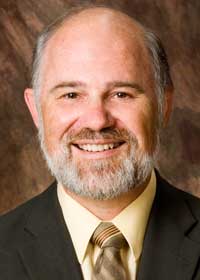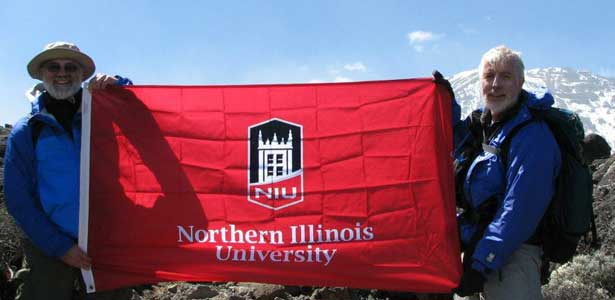Professor Kurt Thurmaier, director of the Division of Public Administration at NIU in the College of Liberal Arts and Sciences, has succeeded in his quest to climb Africa’s highest peak, Mt. Kilimanjaro.
Thurmaier and fellow climbers set out to raise money in conjunction with Tanzania Development Support (TDS), a nonprofit organization that he co-founded with his wife, Jeanine. The money will be used to build a new library and community resource center for Nyegina schools and nearby Bukwaya communities.
The fundraising goal was $19,341; they raised $28,000, a remarkable achievement given the sluggish economy.
“I climbed first to raise money for the school and then, secondly, to see if I could do it,” Thurmaier says.
The climb to the top of Mt. Kilimanjaro (19,341 feet) consists of day hikes that start at 3,000 feet. On the final day of ascent, climbers reach the base camp (at 14,000 feet) around 3 p.m.
In his own words:
You rest then because you’re kind of tired; you’ve been climbing seven-hour days for four days.
 At 11 o’clock, they wake you up and give you hot tea and cookies (biscuits), and at midnight you start climbing to the summit. It’s dark. You have a headlamp, but we had the benefit of an almost full moon. The whole mountainside was bathed in this beautiful, bright moonlight glistening off the snow and glaciers and so on. It was strikingly beautiful. So I climbed most of the time without my headlamp.
At 11 o’clock, they wake you up and give you hot tea and cookies (biscuits), and at midnight you start climbing to the summit. It’s dark. You have a headlamp, but we had the benefit of an almost full moon. The whole mountainside was bathed in this beautiful, bright moonlight glistening off the snow and glaciers and so on. It was strikingly beautiful. So I climbed most of the time without my headlamp.
Although physically it was really demanding – probably the most physically demanding thing I’ve ever done to my body – mentally, it was a real challenge, too. If you look up too many times you can get very discouraged because it doesn’t look like you’re going very far, which really you aren’t.
You have to put one foot in front of the other, heel to toe, and you don’t go very fast. The trail is narrow and precarious and a bit tricky in a couple of spots. You just have to stay really focused.
Thurmaier reached the first summit, called Stella Point, at about 9 a.m. in a white-out blizzard with 40-mph, horizontal winds blowing snow.
“We couldn’t see much of anything. We could kind of see the sign that read, ‘Here’s Stella Point.’ Ohuru is the highest peak, which is another 1,000 feet. Another 20 minutes. You’re exhausted.”
“You climb and you climb and you climb and you get there slowly. The saying is ‘pole pole,’ which means slowly, gently, take it easy. The mountain teaches you patience.”

Kurt Thurmaier (left) and mountain-climbing companion Bruce Rocheleau, NIU professor emeritus, hold the NIU flag at the summit of Mt. Kiliminjaro.
It took Thurmaier nine and a half hours to climb the last mile, a total of 5,300 feet.
“We followed this trail, which had been carved in the snow. It was a gentle slope, but still up. We had to focus where our feet were. You could see the black rock, although it was getting covered with snow. You finally get to the top and there’s a sign that says, ‘Congratulations! You’ve made it to the top of Africa.’ It was an emotional experience at the top. The people in our group are a community now.”
So what’s next? A year from now, Thurmaier will return to Tanzania with students participating in his Study Abroad course. Thurmaier developed and directed the first program in 2009. Students from all majors and colleges are invited to apply; the program is open to undergraduate and graduate students.
Details about the trip in 2013 will be posted soon. Read the Experiential Learning and Development Administration in Tanzania white paper for information about the 2011 trip.
by Rachelle Korth
Related:

